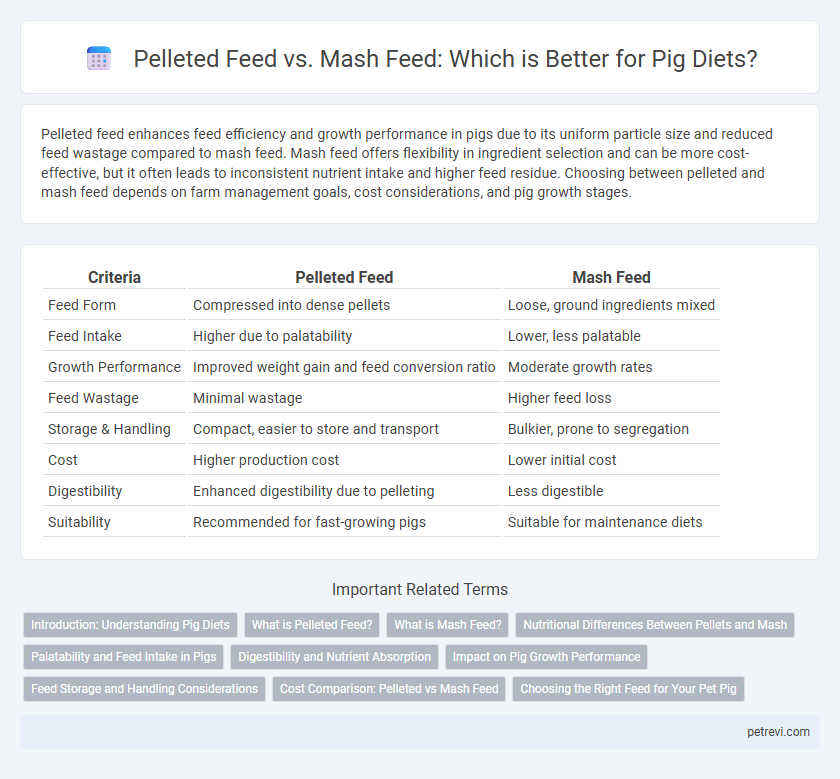Pelleted feed enhances feed efficiency and growth performance in pigs due to its uniform particle size and reduced feed wastage compared to mash feed. Mash feed offers flexibility in ingredient selection and can be more cost-effective, but it often leads to inconsistent nutrient intake and higher feed residue. Choosing between pelleted and mash feed depends on farm management goals, cost considerations, and pig growth stages.
Table of Comparison
| Criteria | Pelleted Feed | Mash Feed |
|---|---|---|
| Feed Form | Compressed into dense pellets | Loose, ground ingredients mixed |
| Feed Intake | Higher due to palatability | Lower, less palatable |
| Growth Performance | Improved weight gain and feed conversion ratio | Moderate growth rates |
| Feed Wastage | Minimal wastage | Higher feed loss |
| Storage & Handling | Compact, easier to store and transport | Bulkier, prone to segregation |
| Cost | Higher production cost | Lower initial cost |
| Digestibility | Enhanced digestibility due to pelleting | Less digestible |
| Suitability | Recommended for fast-growing pigs | Suitable for maintenance diets |
Introduction: Understanding Pig Diets
Pelleted feed for pigs offers higher nutrient density and improved feed conversion ratios compared to mash feed, resulting in enhanced growth rates and feed efficiency. Mash feed, characterized by its loose and coarse texture, allows for easier ingredient customization but may lead to increased feed wastage and inconsistent intake. Selecting between pelleted and mash feed depends on factors such as production goals, cost-effectiveness, and specific nutritional requirements to optimize pig health and performance.
What is Pelleted Feed?
Pelleted feed is a type of pig diet composed of finely ground ingredients compressed into small, dense pellets, improving feed intake and reducing wastage. This form of feed enhances nutrient digestibility and promotes uniform growth by providing a consistent balance of proteins, vitamins, and minerals. Pelleted feed often results in better feed conversion ratios compared to traditional mash feed, supporting efficient pig production systems.
What is Mash Feed?
Mash feed for pigs is a finely ground mixture of grains, protein sources, vitamins, and minerals that remains loose and powdery rather than compressed into pellets. It allows for easier customization of nutrient content and can improve feed intake by pigs who prefer varied textures. Mash feed is often used in small-scale operations or when precise dietary adjustments are necessary for optimal pig growth and health.
Nutritional Differences Between Pellets and Mash
Pelleted feed for pigs offers enhanced nutrient density and uniformity compared to mash feed, improving digestibility and feed efficiency. The pelleting process reduces feed particle size and increases starch gelatinization, which enhances nutrient availability, especially amino acids and energy content. Mash feed tends to have variable nutrient distribution and lower digestibility due to larger particle size and lack of heat treatment, potentially leading to uneven nutrient intake and growth performance.
Palatability and Feed Intake in Pigs
Pelleted feed offers higher palatability compared to mash feed, leading to increased voluntary feed intake in pigs due to its uniform texture and reduced feed wastage. Enhanced palatability in pelleted diets improves nutrient absorption and growth performance, essential for optimizing swine production efficiency. Mash feed, while less processed, may result in lower consumption rates and inconsistent nutrient intake due to its coarse particle size and variable taste.
Digestibility and Nutrient Absorption
Pelleted feed for pigs offers enhanced digestibility and nutrient absorption compared to mash feed due to its compact form, which reduces feed wastage and promotes uniform intake. The pelleting process increases starch gelatinization and protein digestibility, leading to improved feed conversion ratios and growth performance. Pig diets formulated with pelleted feed also support better gut health by minimizing feed selection and promoting consistent nutrient delivery.
Impact on Pig Growth Performance
Pelleted feed enhances pig growth performance by improving feed efficiency and nutrient digestibility compared to mash feed. Studies show pigs fed pelleted diets exhibit faster weight gain and better feed conversion ratios due to reduced feed wastage and increased palatability. Optimizing diet form with pelleted feed supports more consistent growth rates and overall improved production outcomes in swine farming.
Feed Storage and Handling Considerations
Pelleted feed offers advantages in storage and handling due to its compact, uniform form that reduces dust and minimizes feed waste compared to mash feed. Proper storage of pelleted feed requires moisture control to prevent pellet degradation and mold growth, while mash feed demands more frequent stirring and aeration to avoid settling and spoilage. Efficient handling of pelleted feed also enhances feed delivery systems by reducing clogging and improving flow consistency on pig farms.
Cost Comparison: Pelleted vs Mash Feed
Pelleted feed typically incurs higher production costs due to the additional processing steps like grinding, conditioning, and pelletizing, but it offers improved feed efficiency and reduced waste, potentially lowering overall feeding costs for pig producers. Mash feed is generally less expensive to produce, as it involves simple mixing without extra processing, yet it may result in higher feed wastage and slower growth rates, which can increase total feeding expenses. Evaluating the balance between upfront feed cost and performance outcomes is critical for optimizing pig diet economics.
Choosing the Right Feed for Your Pet Pig
Pelleted feed offers enhanced nutrient density and reduced feed wastage compared to mash feed, which can improve growth performance and feed efficiency in pet pigs. Mash feed allows greater customization of ingredient ratios and may promote natural foraging behaviors, beneficial for pigs requiring varied diets or behavioral enrichment. Selecting the right feed depends on factors such as your pig's age, health status, and specific nutritional requirements to achieve optimal growth and wellbeing.
Pelleted Feed vs Mash Feed for Pig Diet Infographic

 petrevi.com
petrevi.com